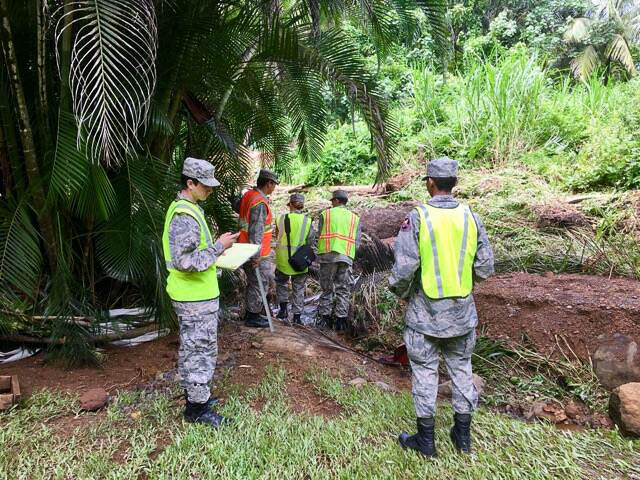Civil Air Patrol Cadets Gather Post-Hurricane Data on Maui

Hawaiʻi Wing Civil Air Patrol cadets formed the bulk of a Ground Photography Team on Maui on Tuesday, gathering photographic evidence of the flash-flood impact resulting from Hurricane Lane. PC: courtesy.
Hawaiʻi Wing Civil Air Patrol cadets formed the bulk of a Ground Photography Team working on Maui on Tuesday to gather photographic evidence of the flash-flood impact resulting from Hurricane Lane.
The Maui Composite Squadron cadets were led by Squadron Commander Major Charles Dryden and Captain Chantal Lonergan, the Hawaiʻi Wing Inspector General. The cadets were Senior Master Sergeants Xiana Crenshaw and Jaden Pladera, Master Sergeant Kaiya Meier, Staff Sergeant Arnubi Gomes, and Senior Airman Jonah Wilsey-Botelho.
The Ground Photography Team was sent out to examine and photograph four locations identified as flood-impact areas by the Federal Emergency Management Agency, covering a distance of over 50 miles.

Hawaiʻi Wing Civil Air Patrol cadets formed the bulk of a Ground Photography Team on Maui on Tuesday, gathering photographic evidence of the flash-flood impact resulting from Hurricane Lane. PC: courtesy.
FEMA has asked members of the Hawaiʻi Wing and the general public to download the agency’s app to their smartphones and use it to take photos of high-water marks from receding floodwaters and water “wreck lines” left by flash floods.
In an email to Incident Command Post personnel, FEMA Geospatial Information Officer Christopher Vaughan applauded CAP’s contributions to the FEMA mission, saying, “The deployment of CAP ground teams to collect HWM’s will drastically change how quickly we (GIS) can generate initial flood extents following impact.”
Meantime, on Hawaiʻi Island, an Oʻahu cadet filled an essential role as Mission Radio Operator at the Kona Incident Command Post. Cadet Captain Zachary Simbajon maintained communication between the Incident Command Post and the Maui Ground Photography Team in order to monitor the status of their operations, their location, and their welfare.

Cadet Captain Zachary Simbajon maintained communication between the Incident Command Post and the Maui Ground Photography Team in order to monitor the status of their operations. Courtesy photo.
The Maryknoll Cadet Squadron member also served as a Mission Staff Assistant to the Incident Command Team, doing whatever tasks would allow adult team members to keep up with phone calls, correspondence, and customer requests.
Civil Air Patrol is a volunteer organization whose mission is to support America’s communities with emergency response, diverse aviation and ground services, youth development, and promotion of air, space, and cyber power. The cadet youth throughout Hawaiʻi make up a large proportion of Hawaiʻi Wing’s trained ground team members.
Major Dryden praised the cadets’ performance saying, “The cadets executed the mission well. They faced and overcame a number of challenges to help make the mission a success. One of the biggest challenges was incorporating multiple technology platforms so that the team could translate location data received from the FEMA tasking into viable routes using available roads and paths. They also practiced radio communications, and at one site, they interviewed local residents affected by the storm.”









